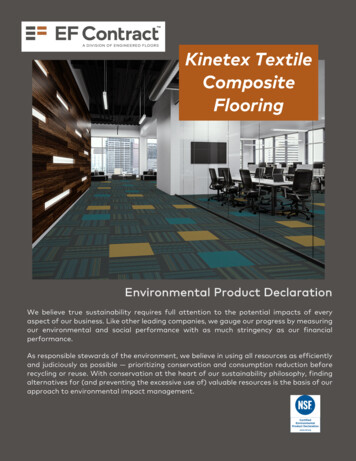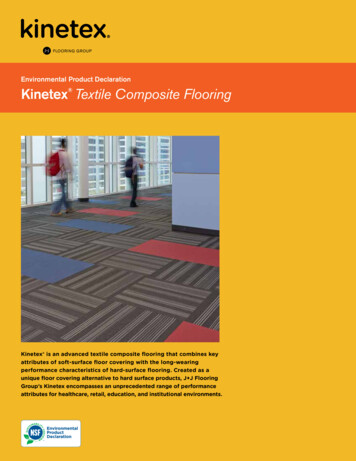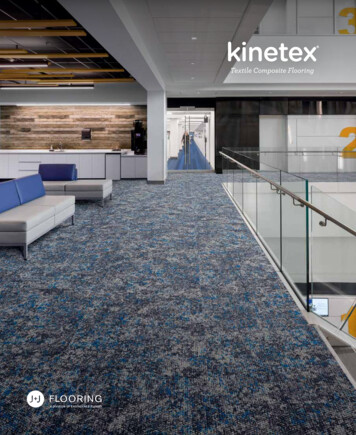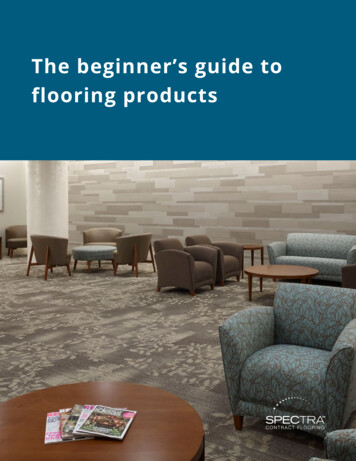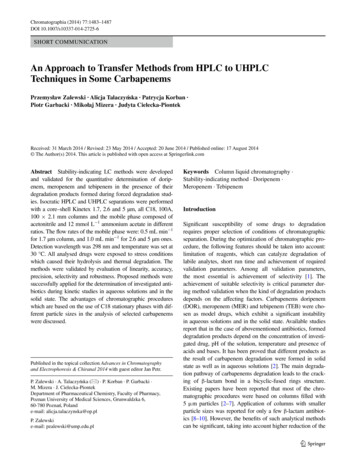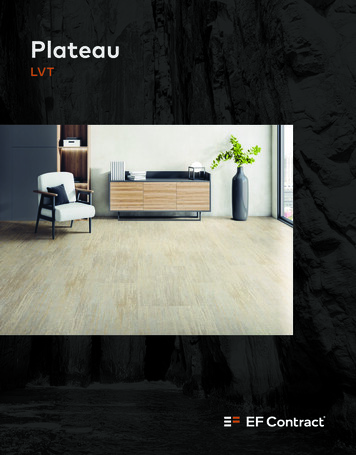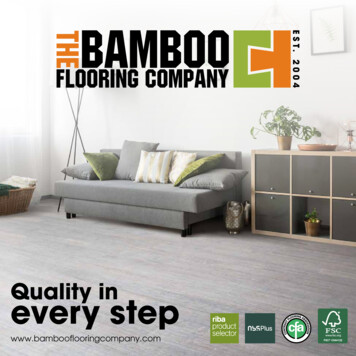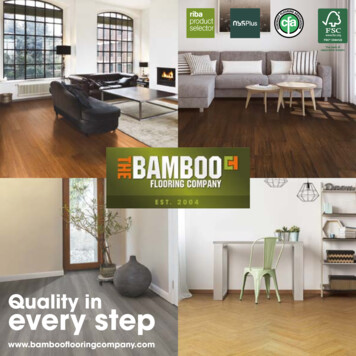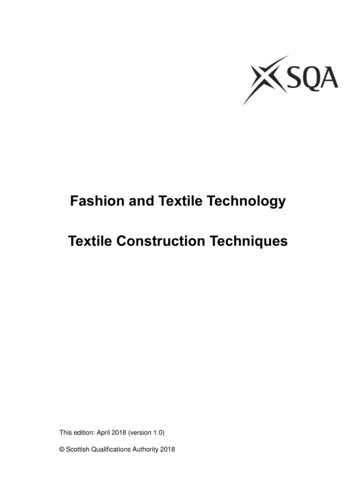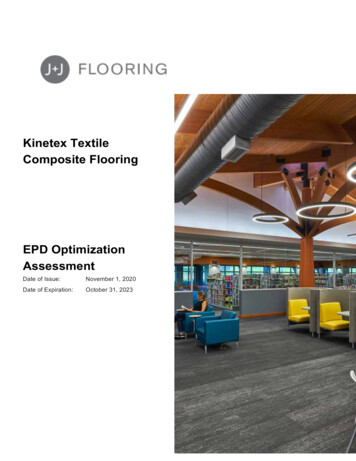
Transcription
Kinetex TextileComposite FlooringEPD OptimizationAssessmentDate of Issue:November 1, 2020Date of Expiration:October 31, 2023
EPD Optimization AssessmentKinetex Textile Composite FlooringProduct InformationManufacturer NameJ J Flooring GroupProduct NameKinetex Textile Composite FlooringImpact Comparison ParametersType of ComparisonCurrent EPDCurrent vs Previous EPD of ProductKinetex Textile Composite Flooring, EPD10175, NSF /ProdCert/EPD10175.pdfLife Cycle Stages ReviewedCradle-to-Shipping Gate (A1-A3)Declared Unit1 sq. meter of flooring coveringImpact Assessment (TRACI)Current EPD of ProductPrevious EPD of Product*GWP [kg CO2eq]5.357.71Resources [MJ]1.05E 011.58E 01POCP [kg O3 eq]1.65E-012.16E-01* Note: The values above will not correspond directly with values disclosed in theEPDs listed above. To complete this analysis, the third-party verifier conducted aseparate analysis based on primary data using the same software platform andmodel. This additional analysis was required to assure that the comparison wasaccurate and meaningful.Impact Comparison ResultsComparison SummaryLEED Credit AchievedVerifier1The current J J product has greater than 20% GWP impact reduction, and morethan 5% Resources and POCP impact reduction than the historical product. LEED v4.0 @ 100% cost LEED v4.1 @ 150% cost/1.5 products LEED v4.1 @ 100% cost/1 product LEED v4.1 @ 200% cost/2 productsMatt Van Duinen, LCACPSustainability Director, WAP SustainabilityDate of Issue11/1/2020Expiration Date10/31/2023
EPD Optimization AssessmentKinetex Textile Composite FlooringThird Party LEED Verification StatementIt is WAP Sustainability’s professional opinion that the product(s) in question meets the following LEEDMaterials and Resource Credit, Environmental Product Declaration, Option 2 criteria: Product Does Not Meet LEED Option 2 Criteria Impact Reduction in 3 Categories (value at 100% by cost for LEED v4.0) GWP Reduction 0% (value at 100% by cost or 1 product for LEED v4.1) GWP Reduction 10 % (value at 150% by cost or 1.5 products for LEED v4.1) GWP Reduction 20 % and Impact Reduction 5 % in 2 Additional Categories (value at200% by cost or 2 products for LEED v4.1)This determination was made for the following reasons: The comparability assessment initially reviewed the EPDs and gaps to comparability were initiallyfound. However, the LCA reports were provided and reviewed. This second level of analysis helped tofill the gaps and provided enough information for us to come to the conclusion that comparability wasachieved. Additionally, a separate LCA-based analysis was conducted to align the LCA software use and timeboundaries of the datasets. Primary data from the 2013 LCA study were extracted, verified and used inthe 2019 LCA study model for analysis. This analysis showed reductions in the footprint outlined in thisdocument. This level of reduction was the basis for determining optimization. GWP reductions of at least 20%, and more than 5% Resources and POCP reductions were shown. The narrative provided by J J was found to adequately address the source of the reductions found inthe comparison. The narrative is attached as an appendix to this report. J J has provided a timeline for publishing this report publicly and given direction as to the location thatthis report will be published.Matt Van Duinen, LCACPSustainability DirectorWAP Sustainability Consulting, LLC2
EPD Optimization AssessmentKinetex Textile Composite FlooringAssessment of Impact ResultsLife Cycle Stages Under ReviewSourcing andManufacturingTransportation andInstallation A1 A2 A3Use PhaseEnd of Life B1 B5 C1 A4 B2 B6 C2 A5 B3 B7 C3 B4Other D C4Functional/Declared UnitAs this comparison reviewed A1-A3 impacts only, a Declared unit is provided rather than a functional unit.Declared UnitProduct Reference Service LifeCurrent LCA/EPD1 sq. meter of flooring covered15Baseline LCA/EPD1 sq. meter of flooring covered15Assessment ResultsAs the original life cycle assessments for the products in question were not performed in a similar manner, the resultswere not directly comparable. An additional LCA-based analysis was necessary to generate the comparison table below,and as such, the results are now directly comparable.3AP [kg SO2eq]EP [kg N eq]GWP [kgCO2 eq]Resources[MJ]POCP [kg O3eq]Kinetex in 20191.21E-029.25E-045.35E 001.05E 011.65E-012013 Kinetex inUpdated Model1.15E-029.42E-047.71E 001.58E 012.16E-01Impact Change5%-2%-31%-34%-23%
EPD Optimization AssessmentKinetex Textile Composite FlooringWAP Sustainability’s Criteria for ComparabilityPer ISO14025, “Type III environmental declarations are intended to allow a purchaser or user to compare theenvironmental performance of products on a life cycle basis. Therefore, comparability of Type III environmentaldeclarations is critical. The information provided for this comparison shall be transparent in order to allow the purchaseror user to understand the limitations of comparability inherent in the Type III environmental declarations.”WAP Sustainability takes this requirement very seriously. No EPD is an exact replica of another. Due to the humanelement and the embodied uncertainty in complex supply chain, there are nearly always limitations to comparability. Thegoal is to limit those limitations. It is important for the user of an EPD to understand that the environmental impact valuespresented are ballpark figures based on the best available science, expert decisions and available budgets. At WAPSustainability, we agree with the above statement taken from ISO14025 and believe that “comparability of Type IIIenvironmental declarations is critical”. Without comparability, the power of LCAs and EPDs to help facilitate a transitionto an environmentally sustainable economy will always be limited. The key is for the comparison to be done in a mannerthat is critically reviewed and open.To facilitate transparency, we have presented our entire criteria for the assessment of comparability in the table below.Data is not at allcomparableData is significantly not Data is comparable butcomparable. Modificationopportunities formay need to be made.improvement exist.Data is highlycomparable.ScoreCategoryScore 0Score 1Score 2Score 3Count01420Note: A single score of 0 will result in LCA/EPD not being able to be compared. Additionally, multiple scores of 1 will result inLCA/EPD not being able to be compared.4
EPD Optimization AssessmentKinetex Textile Composite FlooringComparability Findings Comparable for the Purposes of LEED Credit Achievement Not Comparable for the Purposes of LEED Credit AchievementThe products in question are similar in application, size, and use scenarios. The production method in manufacturing issimilar. The boundary conditions are the same between the studies. Additionally, further LCA modeling and expertanalysis was conducted to account for the difference in PCRs. It is because of these facts that the EPDs are comparable.Current EPDPrevious EPDComparabilityGeneralProgram OperatorNSF InternationalNSF International3NSF International: Flooring1UL PCR Part APCRUL PCR Part B: Flooring EPDRequirementProduct Category DefinitionProduct TypeTextile Composite FlooringTextile Composite Flooring3ManufacturingDescriptionNeedle Punching, mechanicalbonding, bulking, laminating,and embossingNeedle Punching, mechanicalbonding, bulking, laminating,and embossing3Declared or FunctionalUnit1 sq. meter1 sq. meter3Weight Per Declaredor Functional Unit1.344 kg1.495 kg3Reference Service Life(Product)15153Estimated Service Life(Building)N/AN/A3Materials and SubstancesRaw Materials andPercent Listed in LCAor EPD5--2
EPD Optimization AssessmentKinetex Textile Composite FlooringPET Yarn - (%)18.3%17.2%-PE Backing - (%)18.1%15.4%-PET Backing - (%)63.3%67.1%-Non-Fluoro Soil Resist0.5%0%-Goal and ScopeStated Goal of LCA orEPDCreate an LCA for carpetflooring products tounderstand impacts and createEPDsBetter characterizeenvironmental performance ofproducts, create EPDs3Stated Scope of LCAor EPDCradle-to-GraveCradle-to-Grave3Format for DeclarationLCA or EPDEPDEPD, with updated resultsbased on previous primary datain new model3ISO 14025 SeriesComplianceYesUsing the same model as 20193ISO 21930ComplianceYesUsing the same model as 20193EN 15804 ComplianceN/AN/A-Data CollectionAssessed Data QualityData within 10 years, USdatasets when possible,appropriate technologies usedData within 10 years, USdatasets when possible,appropriate technologies used3Vintage of PrimaryData201720123Key Assumptions,OverallAllocation based on productionvolume at plantsAllocation based on productionvolume at plants3Key Assumptions, UsePhaseN/AN/A-Key Assumptions,N/AN/A-6
EPD Optimization AssessmentKinetex Textile Composite FlooringEOL 1% mass 1% mass 1% energy 1% energy 5% total 5% totalPercent of MaterialsLeft Out of Study0-3.09%-2Software Used toModel LCAGaBi 8.7.0.18GaBi 9.2.0.582Source of SecondaryDatasetsthinkstepthinkstep3Vintage of SecondaryDatasetsUpdated 2019Updated 20192Defined Cut Off Rule3Reporting CategoriesLCIA ImpactsAssessmentMethodologyTRACI 2.1TRACI 2.13Description of AnyModifications Made toReporting CategoriesThat Were Necessaryto FacilitateComparisonNoneNone3Equivalency of StagesDescription of AnyModifications Made toLife Cycle Stages ThatWere Necessary toFacilitate Comparison7NoneNone3
EPD Optimization AssessmentKinetex Textile Composite FlooringAppendix: Manufacturer Narrative of Impact ReductionsThe reductions in the impacts between 2012 and 2019 Kinetex were mainly derived from four factors: The per-unit energy consumption for manufacturing the product has been reduced remarkably. The electricityper-unit usage in 2019 had reduced 21.1% since 2012 while the natural gas per-unit usage was about half ofthat of 2012. In addition, the water usage per unit of product in 2019 was only 0.5% of that of 2012. The product research and development has identified those materials with higher recycled content to displacethe usage of virgin materials without compromising the desired product functions. For Kinetex, the recycledcontent had increased from 61% to 63%, mainly in the cushion layer. The carpet architecture improvement has led to a lighter product than 2012, which means less material usagein the product and in turn less impact from material extraction and transportation. The manufacturing of Kinetex had been integrated to one single facility where energy consumption could bereduced and transportation between plants were no longer needed.In addition to above, the measures J J took include changing the packaging configuration which reduced the plasticmaterial while increasing the use of material that is able to capture biogenic carbon.8
Kinetex Textile Composite Flooring 8 Appendix: Manufacturer Narrative of Impact Reductions The reductions in the impacts between 2012 and 2019 Kinetex were mainly derived from four factors: The per-unit energy consumption for manufacturing the product has been reduced remarkably. The electricity
